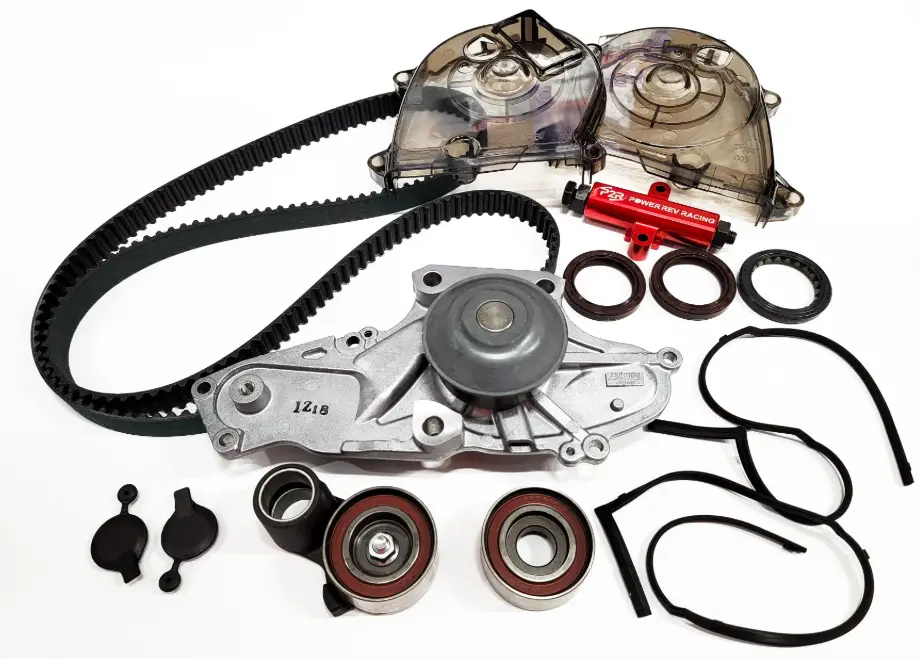Replacing the Honda Pilot’s timing belt every 60,000 to 100,000 miles prevents severe engine damage. A broken belt can lead to costly repairs, including bent valves and damaged pistons. Timely replacement ensures reliable engine performance and long-term vehicle health.
The Honda Pilot, known for its reliability and versatility, is a popular choice among SUV enthusiasts. However, like any vehicle, it requires regular maintenance to ensure longevity and optimal performance. One of the critical components that need periodic attention is the timing belt.
This guide covers everything you need to know about Honda Pilot timing belt replacement, from its importance to step-by-step replacement procedures and answers to common questions.

Contents
What is Timing Belt
The timing belt is an essential component of the Honda Pilot’s engine. It synchronizes the rotation of the crankshaft and the camshaft, ensuring that the engine’s valves open and close at the right times during each cylinder’s intake and exhaust strokes. This synchronization is important for the engine’s efficiency and performance.
Why Timing Belt Replacement is Important
Failure to replace a worn timing belt can lead to severe engine damage. If the timing belt breaks, the engine’s pistons can collide with the valves, causing bent valves, damaged pistons, or even complete engine failure. Regular replacement prevents these costly damages and ensures smooth engine operation.
Recommended Replacement Interval
Honda recommends replacing the timing belt in the Pilot every 60,000 to 100,000 miles, depending on the model year and engine type. It’s advisable to consult your owner’s manual for the specific interval for your vehicle. Additionally, consider replacing the water pump, tensioners, and pulleys during the timing belt service as they wear out over time.
Signs Your Timing Belt Needs Replacement
- Ticking Noise from the Engine: A worn timing belt can produce a ticking sound.
- Engine Misfires: Improper belt function can lead to engine misfires.
- Oil Leaks: Leaks near the timing belt cover can indicate issues.
- Difficulty Starting the Engine: A failing timing belt can disrupt the engine’s starting process.
- Engine Vibrations or Shaking: A loose or worn belt can cause noticeable engine vibrations.
Step-by-Step Guide to Timing Belt Replacement
Follow the step by step guide below to replace timing belt successfully –
Tools and Materials Needed
- New timing belt kit (includes belt, tensioner, and pulleys)
- Socket and wrench set
- Screwdrivers
- Jack and jack stands
- Torque wrench
- Replacement water pump (optional but recommended)
Step 1: Preparation
- Park the vehicle on a flat surface and engage the parking brake.
- Disconnect the battery to ensure safety.
- Lift the vehicle using a jack and secure it with jack stands.
Step 2: Remove Engine Covers and Accessories
- Remove the engine cover and any components obstructing access to the timing belt (e.g., serpentine belt, alternator, power steering pump).
- Drain the coolant if replacing the water pump.
Step 3: Align Timing Marks
- Rotate the crankshaft to align the timing marks on the crankshaft and camshaft pulleys. This ensures the engine is at top dead center (TDC) on the compression stroke.
Step 4: Remove the Old Timing Belt
- Loosen the tensioner and carefully remove the old timing belt.
- Inspect the pulleys and tensioner for wear and replace if necessary.
Step 5: Install the New Timing Belt
- Install the new belt, ensuring correct alignment with the timing marks.
- Tension the belt according to the manufacturer’s specifications.
Step 6: Reassemble Components
- Reinstall the removed components, refill the coolant if applicable, and reconnect the battery.
Step 7: Test the Engine
- Start the engine and listen for any unusual noises.
- Check for leaks and verify the engine runs smoothly.

Cost of Timing Belt Replacement
The cost for a Honda Pilot timing belt replacement typically ranges from $500 to $1,000. This includes parts and labor. Replacing the water pump and other components may increase the total cost but is a wise investment for long-term reliability.
DIY vs. Professional Replacement
While DIY replacement can save money, it requires mechanical expertise and proper tools. Mistakes can lead to significant engine damage. If unsure, it’s best to have the replacement done by a certified mechanic.
Frequently Asked Questions
Here are some FAQs about honda pilot timing belt replacement –
1. How often should I replace the timing belt on a Honda Pilot?
Honda recommends replacing the timing belt every 60,000 to 100,000 miles. Check your owner’s manual for specific guidelines.
2. Can I drive my Honda Pilot with a worn timing belt?
Driving with a worn timing belt is risky. If it breaks, it can cause severe engine damage. It’s best to replace it as recommended.
3. Should I replace the water pump with the timing belt?
Yes, replacing the water pump along with the timing belt is recommended because they have similar lifespans and the labor overlaps.
4. How long does it take to replace a timing belt?
Professional replacement typically takes 4 to 6 hours, depending on the mechanic’s experience and the vehicle model.
5. What happens if the timing belt breaks while driving?
If the timing belt breaks, it can lead to catastrophic engine damage, including bent valves and damaged pistons, requiring costly repairs.
Conclusion
Regular timing belt replacement is essential for maintaining your Honda Pilot’s engine health. Understanding the signs of wear, adhering to replacement intervals, and considering professional service can prevent costly repairs and ensure reliable performance. Whether you choose to replace the timing belt yourself or hire a professional, timely maintenance is a critical step in prolonging your vehicle’s life.